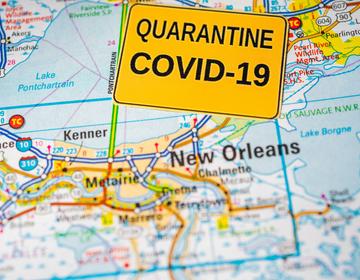Dr. Oliver Sartor on COVID-19: This Week in New Orleans and The Race for A Treatment
This interview, “Dr. Oliver Sartor on COVID-19: This Week in New Orleans and The Race for A Treatment,” is provided by Grand Rounds in Urology’s content partner, Prostatepedia.

Dr. Oliver Sartor, is the Laborde Professor of Cancer Research in the Medicine and Urology Departments of the Tulane School of Medicine, the editor-in-chief of Clinical Genitourinary Cancer and the author of more than 400 scientific papers.
Prostatepedia talks with him about what is happening in New Orleans this week, the race for potential treatments, and why New Orleans and New York City have been hit so hard with COVID-19.
How is the situation in New Orleans this week?
Dr. Oliver Sartor: We’re on day 17 of our mayor declaring closure, and people are being good as a whole. I know there are exceptions. But the rule is that people are staying inside, distancing. There are more people wearing masks on the street. We’re now masking in the clinic when we go in, and we have stringent screening for anybody who comes into the clinic. It’s starting to have a positive effect. Our new cases are leveling out. We’re not getting as many admissions. The two main hospitals that I interact with for conference calls are in no danger of running out of ventilators. We’re getting people off ventilators as well. New Orleans is bending the curve, not to a point where we could or should be out in the streets, but social isolation for a 17-day period makes a difference.
Is it true that the COVID-19 death rate in New Orleans is higher than New York?
Dr. Oliver Sartor: That is dependent on the type of reporting and type of testing. But in New Orleans, there are a lot of people that have comorbidities. It’s an older population compared to other population centers, like San Francisco. We got hit with the virus early and hard. Those figures are representative of an earlier event, so I’m unsure about how to compare rates from place to place given degrees of maturity and degrees of testing different populations.
There have been a number of deaths in New Orleans and Louisiana, but one of the big drivers is we had the first big outbreak in a retirement home, where 80 people were infected. The typical patient there is 83 years old and has comorbidities.
Why do you think New Orleans was hit so hard so early?
Dr. Oliver Sartor: I believe that Mardi Gras played a role. New Orleans has about a million people in the metropolitan area. An additional 1.4 million people come from all over the world to visit during Mardi Gras. And nobody was really thinking about it. Mardi Gras is a party where people gather in the streets, watch parades, and go to dances and concerts. There are a lot crowds. Mardi Gras was the perfect environment to kick this thing off.
With New York, it makes sense given that it’s such a dense population and they rely so heavily on public transportation.
Dr. Oliver Sartor: And people come to New York from all over the world, too. People from Wuhan, from Iran, from Italy. It’s not only the densest population in the United States, but also the one that incorporates more travelers on a weekly basis than anywhere else.
How do you feel about upcoming clinical trials, like the one with Dr. Alexander Meisel that we discussed last week?
Dr. Oliver Sartor: It’s going to require a village to pull any of these trials off, but there are many promising ideas. One paper from last week had a couple of commercially available compounds that have some activity in their testing. One of them had previously been given to humans with a safety profile, which means you wouldn’t have to go through all of the usual Phase I processes. A report from China included hydroxychloroquine in a control setting. It seemed to indicate that in low and intermediate acuity patients, the deterioration to severe disease bonded with hydroxychloroquine. There are a lot of good investigators, and a lot of good work is going to happen in the next four to eight weeks. One of the advantages of bending the curve is getting the opportunity for scientists and clinical researchers to be able to explore these leads and come up with some preliminary data.
Do you have any new comments for prostate cancer patients this week?
Dr. Oliver Sartor: We’re masking all the visitors to our clinic. We’re not allowing visitors into the clinic, just the patients themselves. We realize a lot of patients have caregivers that are intimately involved with their care, so we are getting them involved with telephone calls. I’ll put my cell phone on the desk so the wife, daughter, or brother can listen as the patient and I talk. We’re being more remote this week than last week.
Everybody is scared, particularly in this older group of prostate cancer patients. People are worried about having cancer and being immunosuppressed, being more susceptible to the virus. I give a lot of reassurances. Most of the patients that we have are not on immunosuppressant therapy.
Finally, I’ll simply say please adhere to the stay at home orders and minimize your travel and exposure. It really will make a difference in terms of the infection rate and flattening the curve. Give the research time to be able to have an effect on the virally infected patients. I believe that within four to eight weeks, we’re going to be having some important leads about how to help infected patients.
Not a member? Join Prostatepedia to read the rest of this month’s conversations.
View this interview on the Prostatepedia website or leave a comment here.
